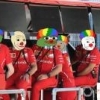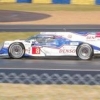Original by AMuS in German, my translation: Pat Fry: "The car was not fantastic, but ok".
The F2012 started the winter tests with problems. How big were they really?
Fry: Some things didn't work as planned. We also made a number of fundamental errors. Initially the task was to localize and fix those. The first test gave us a bad awakening, the second answered our questions, but we didn't have the time until Melbourne to react. That happened with the Barcelona update
What was it that was so wrong?
Fry: I don't want to talk about details. Most errors were in the aero. First we had to understand them. Our first exhaust version heated the rear tyres too much. For the season start we had to fix that with a different exhaust version. In Canada we returned to the original exhaust concept, but in a different form. This worked surprisingly quickly, looking at the problems other teams had with it.
Did you fix your wind tunnel problems?
Fry: Has anyone ever really solved their wind tunnel problems? Correlation between tunnel and track is always tricky, as long as you cannot put your race car into the tunnel. We have understood the deficits of the Maranello tunnel and are working on fixing them. In the mean time, we are using Toyota's tunnel. But Toyota's tunnel is not perfect, either. It's a tool, and you need to know how to use it and to interpret it. Everybody has correlation problems, but ours were greater in recent times.
How big is the danger to get bogged down by using two tunnels?
Fry: The more variables you are dealing with, the greater the chance to get lost. Your tunnel time is limited due to resource restriction. If you need to correlate results from two tunnels and the track, it naturally becomes more complicated. Ideally you would like to have one tunnel that you understand completely. I hope that we will get there at one point.
Why was the F2012's race pace so much better than the quali pace?
Fry: That's a puzzle for us as well. Only in the middle of the season we were as good in quali as in the race. I don't know, either, what we would lose in the race by making our car quicker in quali. Many things have an influence. Just one example: you can have a DRS with a big top speed gain, but you might pay with a car that is unstable when switching the DRS. In the race this is not so important, because you rarely use DRS. Which means that with such a system you will be stronger in the race compared to quali. In the end everything comes down to one task: finding more downforce.
Was it because the Ferrari was kinder to the tyres, which was a handicap in quali because the tyres took longer to reach their working window?
Fry: That depends on the type of track. When the rear tyres were critical, our car was strong in the race. But that didn't have anything to do with quali. In quali, the important thing is to get the front tyres up to temperature quickly. Conversely, we had more problems in race trim on tracks where the front tyres were worked a lot. In short: our quali pace was always the same. In the race it depended on whether the rear or front tyres were the deciding factor.
Why was your car so good in the rain?
Fry: I don't think that the cause was our car. Rather, it was Alonso. Especially in Malaysia, when our car still was difficult to drive. He did an unbelievable job there. And when he was half a second faster than the rest in Hockenheim, that was the driver and not the car.
Why did the F2012 work better on high-speed tracks?
Fry: Did it? Okay, in Monza we could easily have been on pole without the problems at the rear suspension. I'm not so sure we were especially strong in Spa. But one could see our problems become bigger the more downforce the track required.
Your main opponent had to track back from three or four development steps during the season, because the FIA outlawed them. Is Ferrari too well-behaved? Do you not exploit the gray areas of the rules enough?
Fry: There were things on other cars that were at the limit of the regulations. Illegal would be too hard a word. But if you angle a pull rod (? original: "Zugstrebe") at 27 degrees instead of the allowed 5 degrees, you are provoking your luck. How far do you want to go? I don't know.
Would you have liked to change something fundamental on the car during the season, but couldn't due to time constraints?
Fry: Not really. The things we wanted to change, we changed. The fundamentals of the car were ok. After we had fixed the aero problems, the car behaved the way we expected. Not fantastic, but ok. There was nothing that stood in our way. Ok, we had problems on some tracks to get the weight distribution the way we wanted it, but everyone had that particular problem. But that was only a small compromise.
Why didn't you try to control tyre temps by using adjustable break cooling inlets, like McLaren?
Fry: I had started to develop that concept when I was still at McLaren. It can be an advantage if you use brake disks by Carbon Industries. We had less problems with tyre overheating than McLaren. Therefore we passed on this development. We rather use KERS to influence the front and back brake temps.
How many different front and rear wings did you use during 2012?
Fry: Three families of front wings, with fifteen subtypes. We had six rear wing families, but used only three of those. We had 18 different floor versions. For the exhaust, we changed lots of things prior to the first race, because we had to solve the rear tyre heating. Then there was a big modification for Montreal, and that was it. We later tried to vary that position, but the Montreal version was the best solution.
Why did the car not react well to most of the modifications during the second part of the season?
Fry: We were a long way back at the start of the season. That always makes it simple to make big steps. For us, those came in Barcelona and Montreal. Usually, you can improve half a tenth or a tenth between two races, but the observer does not notice this, also because the effects of the improvements can vary from track type to track type. We also improved during the second part of the season, but not as much as the others did. There are two philosophies about how to develop your car. There's the Mercedes or Honda philosophy of waiting three or four races and then bringing a big step. And there's the way that is used by RBR, McLaren, and also Ferrari. To bring a little bit to every race. Every team has phases during which its improvements are bigger or smaller. McLaren had the best car at the start, then stagnated, and was strong at the end again.
Why did you not develop a double DRS like RBR or Merc?
Fry: We looked at the Merc system in detail. It gives you an advantage in quali, because you can run less ride height at the front. But honestly we had more important problems to solve at the start of the season than working on a double DRS. I had to answer the question, do you want to gain 25 milliseconds by running the front of your car lower, or half a second by conventional development work and fixing errors? I believe that the double DRS has not only given Merc an advantage. The requirement of running channels inside the rear wing end plates causes limitations for the end plate shape. The channels through the car cause limitations for the whole rear. Had our car been quick from the first race, we might have developed in that direction. At the end, nobody went down the Merc route. All other variants of double DRS only tried to stall the flow at the upper and lower rear wing element at the same time.
The Ferrari was the only car with a pull-rod front suspension. Was it worth it?
Fry: In any case this was not our problem. You can lower the CoG und gain little aero advantages. We solved the structural problems well.
But it was difficult for the mechanics to adjust the front suspension?
Fry: It had already been difficult before. We had improved the service friendliness [of the pull-rod], but the introduction of the two vanes under the nose made it worse again. We have an approach to solve the problem for 2013. Rather an evolution than a revolution.
Will you keep the pull-rod front suspension on the 2013 car?
Fry: We will build on it, but it will look a bit different. I would not be surprised if some teams followed our example. When we talked about it for the first time, the reaction was: that's crazy. But when you weigh all advantages and disadvantages, it's not so stupid.
On average, Ferrari had the best pit stops. How did you achieve that?
Fry: We still can improve the speed of our stops. There is still a lot of development work in that direction happening on the car, such as the design of the wheel nuts, wheel hubs, brake drums, and the tools like jacks and guns. At the factory we already have an old car fitted with the 2013 suspension design, and the guys are busy practicing with that. Our pit stop average time is good. I know that Sam Michael at McLaren is proud of their pit stop record of 2.3 secs at Hockenheim. But he forgot to mention that their next stop took 11 seconds. And we won the race because we had the better stops on average. If you analyze the stops in detail, you can see we are the quickest from the car coming to a stop until the traffic light switches to green. We sometimes lose compared to McLaren during the subsequent acceleration from the pits. At McLaren, they let the car fall from the jacks without any kind of security margin. Sometimes, their front wing pushes the front jack out of the way when the car launches. That way, you can do 2.3 second stops.
Edit: typo
Edited by KnucklesAgain, 19 January 2013 - 13:15.

































